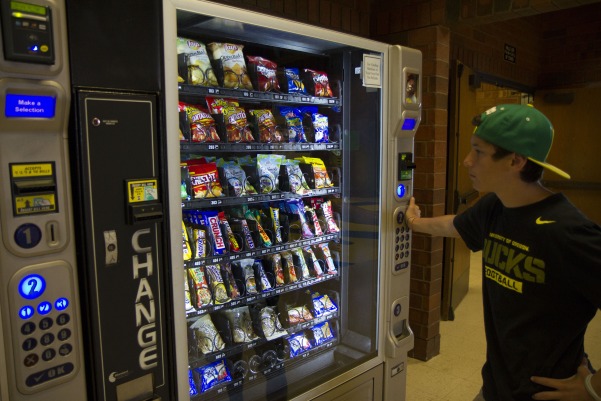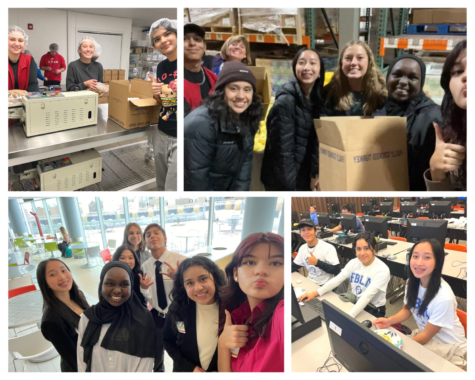New policy alters vending
Snack Options limited due to new health laws
Junior Joe Nino explores his choices at the vending machine, which have changed in size, prize, and type, as a result of the new district policy pushing for better eating habits among students.
October 22, 2014
The flashing numbers and brightly-lit, undisputably delicious merchandise available in the Commons has always drawn students’ attention with great ease, but this year it is a lack of appeal that has heads turning to school vending machines.
According to the Healthy, Hunger-Free Kids Act, schools must now follow calorie restrictions with what they sell in their vending machines and other student-accessible food spots during the school day, in an effort to lower childhood obesity and bad eating habits.
The law, passed in 2010, has come about gradually, in waves, with the alterations in school lunch and soda machines being the first real push. Granite School District created the new food policy prior to the coming school year and, despite potential financial hardship, continued forward with the changes.
What do these alterations entail? Students notice a change in not only brand and type of snacks, as well as complete removal of certain candies and sugary snacks, but also serving size and pricing. For example Pop-tarts, once offered a dollar for two, now sell at the same price for only one.
“In the future,” said Principal Dr. Garett Muse, “…the companies, now that they know what’s happening, will maybe come up with some products that we can put in the machines, but they’re limited on the amount of products we can put in, and kids don’t necessarily want what they see in there.”
The new and revised district policy states, “Schools are encouraged to consider limiting all food vending
to offerings that meet the following criteria: 250 calories or fewer, fewer than 35% of total calories from fat, and less than 35% of weight from sugar.”
This new criteria and change of options elicit mixed feelings from the student body. Not all have detected the alteration, and continue to buy and eat whatever is offered. Senior John Holmes, however, noticed from day one. “Changing things like only getting one Pop-tart for a dollar when you used to be able to get two for a dollar is absolutely unfair,” said Holmes. “Teenagers won’t want to get anything from the vending machines anymore because they feel that they are getting ripped-off…Even though I can see the intentions of wanting teenagers to eat healthier, it still seems a little unfair because people want what they want!”
However, as part of the new regulations, school vending machines can time-on twenty minutes after school and make available certain foods that would not be legal during the school day, in order to accommodate students and visitors at after-school activities (sporting events, theatrical and musical performances, and so on).
This recent change in policy not only affects vending machines, but the student store (Warrior World) as well. FBLA adviser Tori Wouden says students should expect a huge difference in inventory, from the removal of breadsticks, hot pockets, candy, and gatorade, to the new placement of Domino’s Pizza, Veggie Straws, Sobe Water, and Powerade Zero. Wouden expects this change in Warrior World, the revenue of which FBLA relies heavily upon for the funding of trips and competitions, to hit them hard financially. “In reality,” said Wouden, “kids will just go somewhere else.”
Senior Janet Tran, vice president of FBLA, realizes the downside of the alteration, but continues to look forward with optimism. “The new restrictions have been detrimental to almost all food vendors at our school,” said Tran, “but I personally believe that Warrior World will soon be stocked with appealing and healthy items.”
Those in charge of the student store are not the only ones to be injured monetarily, however. “I would expect to see at least a fifty percent drop,” said Muse concerning the money earned from vending machines, “at least fifty percent of the revenue, if not two-thirds. When the soda pop change came in, I figured we dropped up to at least three-fourths or more of the income that we earned.” Vending money normally goes toward the cost of officials at sporting events, subsitute teachers, conferences teachers are required to attend, and so forth.
The main expense vending machine revenue feeds into, however, and the biggest issue due to decrease in profit, is bussing. “The district gives us some bussing allowance,” said Muse, “and then we go above that bussing allowance about 12, 13 thousand dollars by the time you do athletics and field trips.” Since his initial estimate, the vending companies have informed Muse that, after two and a half weeks into the school year, sales are down 80% than what they would normally be.















